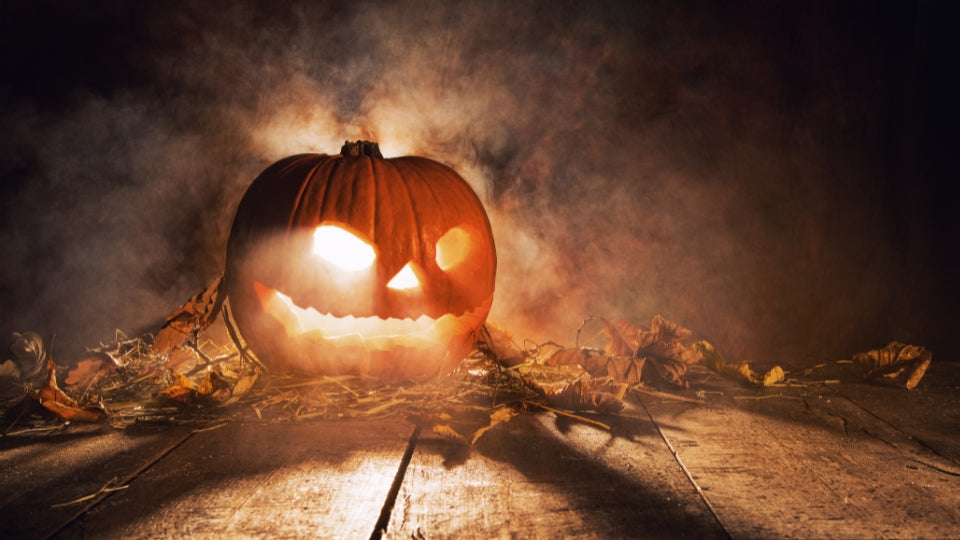
Halloween - Calan Gaeaf
Brythonic people are known for their traditional feasts and festivals that mark the passing of seasons, one of which is Calan Gaeaf (kah-lan gay-av). This literally means ‘the first day of winter’. Though today most people would associate the holiday with plastic pumpkins, there are many unique traditions that are deeply rooted in Welsh history.

The term Calan Gaeaf consists of two words:
Calan: masculine noun, derived from the Latin calendae ‘the first day’ or calends (which we translate in English as the first day of the month in the Roman calendar) – the calends was used to note the beginning or the new month – this was linked to the lunar cycle; the Welsh word calendae was borrowed during the Roman occupation (43-410 AD). After the Roman occupation, the Roman calendar of time had been adopted in Wales and was used to calculate seasonal festivals such as Calan Gaeaf (the first day of winter) or Calan Mai (May Day).
Gaeaf: masculine noun meaning ‘winter’. Pronounced ‘gay-av’. Its origins can be traced back to the Middle Welsh gayaf.
Mutations
- Soft Mutation: Ei galan gaeaf (his Halloween)
- Nasal Mutation: Yng nghalan gaeaf (in Halloween)
- Aspirate Mutation: Ei chalan gaeaf (her Halloween)
Historical and Cultural Significance of Calan Gaeaf
Calan Gaeaf is not a normal day on the calendar, but rather the turning point between autumn and winter, and was originally a pre-Christian festival that marked the close of the harvest season. It is often considered the equivalent of the Irish Samhain, another liminal celebration. This is the night, according to tradition, when the boundary between the living and the dead disappears, and when spirits roam the earth. People would prepare large meals, keep their doors open and leave empty seats at the table so that dead ancestors could visit and have a chat with their living relatives.
According to the Celts - it was believed that ghosts and fairies were abroad on Noson Calan Gaeaf (the eve of Calan Gaeaf), so people lit bonfires against the spirits, and sometimes carved faces into root vegetables, such as mangolds or swedes, the ancestor of the turnip, just as people do today with pumpkins at Halloween.

During this time of the year (the eve of winter) Farm Hands’ contracts would come to an end, so the farmer would throw a party to thank them for their work. They would have a bonfire where they would burn the overgrowth. Have you ever been blackberry picking after Halloween? Of course you haven’t! The stories were that the goblins and fairies would spit on them after Michaelmas and that’s why they would change colour. But the origin story is that it probably made you sick and was used as a deterrent. So, the farmers would cut this back and throw it on the fire. The young people would get a small stone and mark it and throw it in the fire. The following morning, they would look for their stone in the ashes. If they found it, they would carry it with them for the rest of the year to give them good luck. The belief was that if your stone was missing or cracked the next morning, it was an omen of death or bad luck for the upcoming year.

One of the scarier Halloween stories is of the Hwch Ddu Gwta (Black sow). At the end of the party, the last farm hand to leave the party would be chased. They would run as fast as their legs would carry them towards the gate. Some tricksters would take the gate off its hinges…allowing the black sow to remain on the chase. These old wives’ tales spread through Welsh generations and children would all run home when the fire started to die out. They believed that if they stayed, the Hwch Ddu Gwta would devour their souls. One particular rhyme shows how the last child out on Nos Calan Gaeaf was at risk of being eaten by the fearsome beast:
"Home, home, at once, let the tailless black sow snatch the last one"

Safety and preservation of livestock during the harsh winter months was just as important to people in the Iron Age as it is today. By dressing in costume and going door to door in song, it was thought that the bribe of treats would appease the spirits and they would not kill your livestock during the long winter. While vandalism associated with Halloween has dropped dramatically over the years, the idea that those who gave treats would be spared damage to property is clearly a throwback to appeasing wandering spirits for protection.
Today, Halloween has become increasingly popular, with celebrations growing each year. Cardiff Castle hosts an underground cinema annually, screening seasonal classics like The Nightmare Before Christmas and Hocus Pocus. Schools regularly hold Halloween parties where children dress up, and more homes are decorated for the occasion. Bars, clubs, and businesses across the country, and beyond have embraced the festivities, with universities and workplaces joining in by decorating, dressing up, or hosting parties.

While Halloween's modern popularity is undeniable, it’s easy to forget the rich Celtic traditions of Calan Gaeaf and Samhain that it stems from. As we enjoy these newer customs, it’s important not to lose touch with the deep-rooted practices of our ancestors. Preserving the stories and rituals of Calan Gaeaf ensures that this vital part of Welsh heritage is not forgotten.
Test Your Knowledge: Calan Gaeaf Quiz 🎃
Thanks for reading! How well did you pay attention? Answer these questions about Calan Gaeaf in the comments below, and feel free to share your thoughts or experiences related to the traditions. Happy Halloween!
1. What does the term “Calan Gaeaf” literally mean?- A) The end of autumn
- B) The first day of winter
- C) A celebration of ancestors
- D) The beginning of spring
2. What is one traditional activity associated with Noson Calan Gaeaf?
- A) Carving pumpkins
- B) Lighting bonfires
- C) Singing carols
- D) Building snowmen
3. What was believed about the stones thrown into the bonfire by young people?
- A) They would disappear completely.
- B) Finding it meant good luck for the year.
- C) The stones would turn into candy.
- D) They would be blessed by the spirits.
4. Which creature is associated with the tale of the last farmhand at the party?
- A) The Hwch Ddu Gwta (Black Sow)
- B) The Tooth Fairy
- C) The Giant
- D) The Dragon
5. How has modern Halloween in Wales changed from its traditional roots?
- A) It is less popular now.
- B) There are fewer parties.
- C) It is celebrated with more commercialism.
- D) It no longer includes costumes.
Explore more Welsh Halloween Traditions here!


1 comment
Wonderfully informative. Thank you for your research and writing.